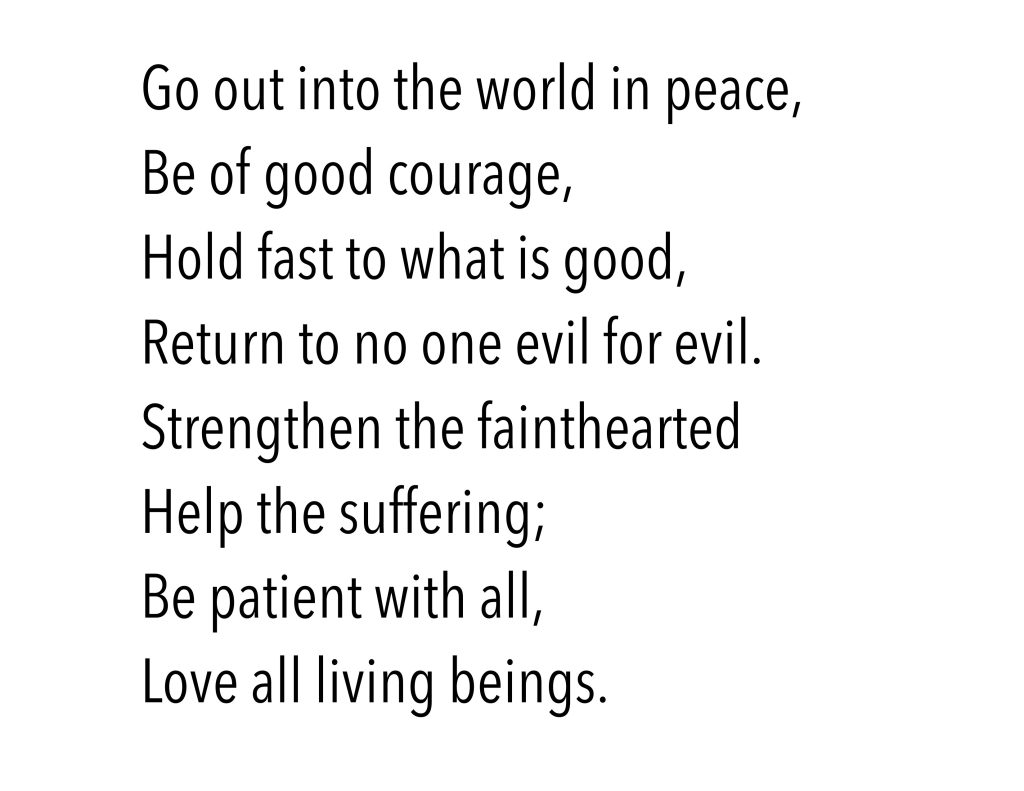Beginnings: Myths and stories from world religions
A curriculum for upper elementary grades by Dan Harper
Copyright (c) 2014, 2024 by Dan Harper.
Back to Table of Contents | On to Session 5
The First Seven Days: A Story from the Ancient Near East
This story can be found in the Hebrew Bible, in the very first book of the Bible — the book of Genesis. (“Genesis” is an ancient Greek word meaning “beginnings.”)
We don’t really know when this story was first told. Storytellers repeated ancient stories in which the world was imagined as being flat and circular. The stories told of the sky as a great high dome covering the top of the earth, and of the sun, moon, and stars as lights fastened to that dome. Above that dome, the stories imagined waters above the sky. Rain came when windows in this dome were opened and some of the waters above the sky fell to earth as rain.
These stories told about a god who lived above far above the waters above the sky, in the heaven of heavens. This god could come down to earth any time he wished. Like the ancient Greeks, these stories told of an underworld (which they called “Sheol,” where the Greeks called it “Hades”), a place where you would go after you died.
The way these stories told about the universe was poetic, not scientific. These ancient stories were not trying to state scientific knowledge about the world. Instead, they were trying to express their poetic understanding of the place human beings inhabited in the universe. We human beings have always felt as though we are the center of the universe, and that’s just where the ancient Hebrews placed humankind — at the center of the universe.
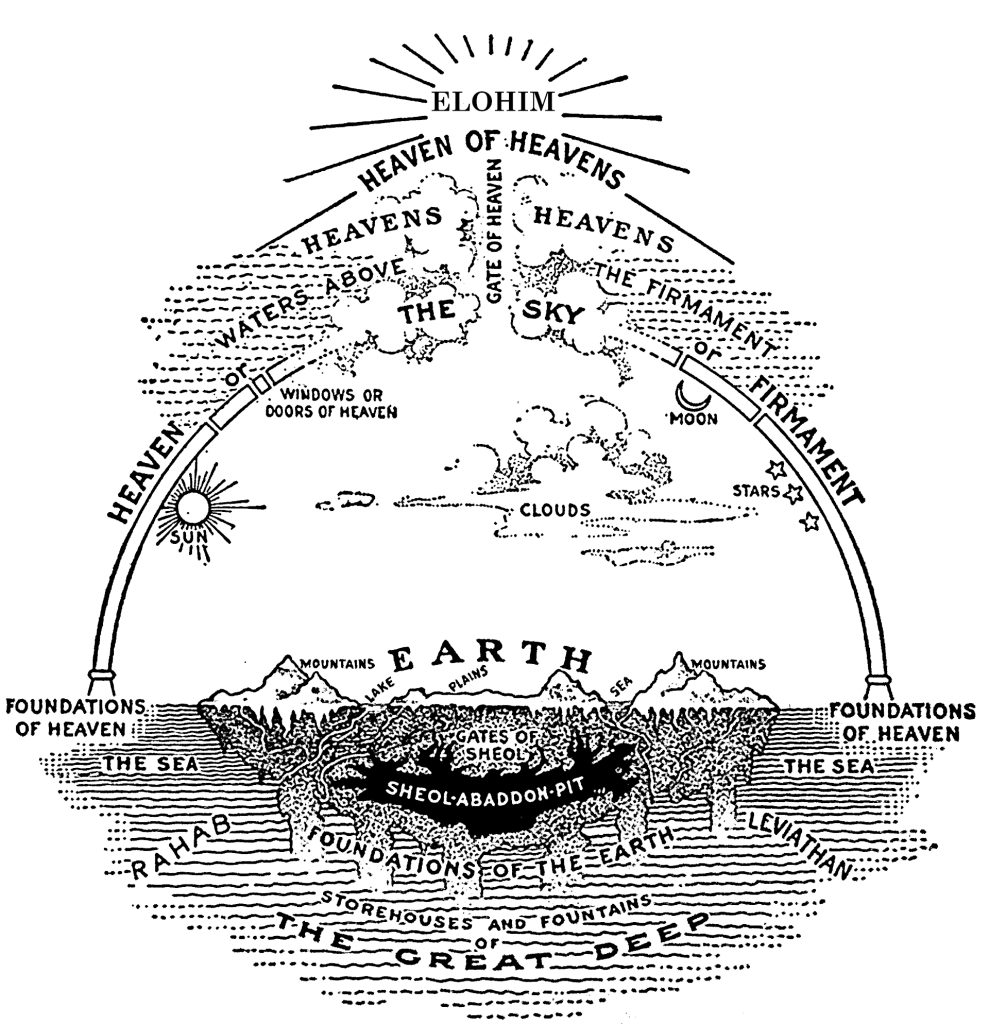
After being passed down from one storyteller to the next for many centuries, the stories were finally written down in the Hebrew language. In Hebrew, the name of the god was “Elohim” (E-loh’-heem). The ancient Hebrews had more than one name for their god. The story following this one will also be from the Hebrew Bible, and in that story the Hebrew god is called by another name, Yahweh (Yah’-way). It is thought that the different names for God show that these old stories were originally told by different people, and then later they were both included when the Hebrew Bible was written down based on many such old stories. Yet even though the stories use two different names for the Hebrew god, they represent the same basic god — a creator who existed before the world began, and brought into being all that is.
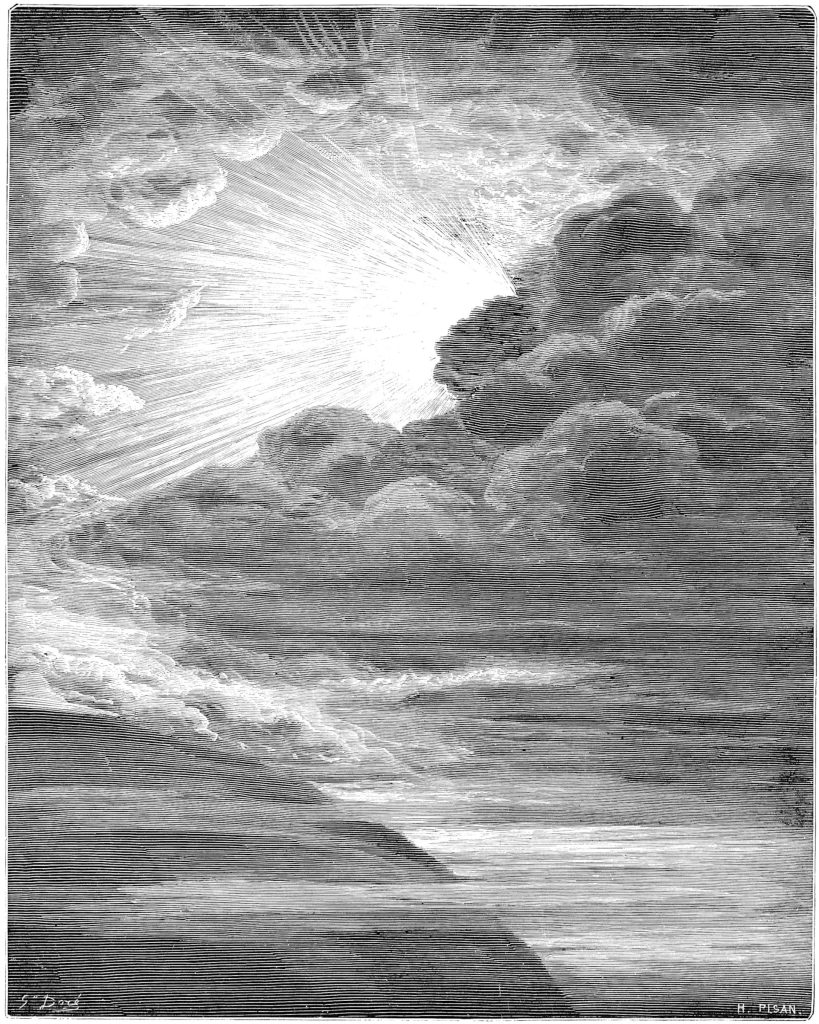
The First Seven Days
Once upon a time that had no time, a being lived in a place that wasn’t really a place. This being did have a name, but the being’s real name cannot be spoken. Because of this, it’s easiest to call the being “Elohim.”
Before time began, before you could even say there was a before, or an after, Elohim looked around, and saw that nothing had any shape or form to it. All around Elohim, it was just nothingness. Or perhaps there was water, and there was wind, and the wind was Elohim. Either that, or Elohim seemed like wind and all around Elohim was everything that ever was, or is, or could be, but it was all mixed up together as if it were a vast ocean.
Elohim decided to separate out light from darkness, and when Elohim did that, time began. Elohim looked at the light and the darkness, decided that they were good. Elohim called the darkness “Night,” and the light “Day,” which meant there now was evening and morning, and that was the first day of all time. But no one knows how long that first day lasted, for in the beginning time did not flow in the same way it does now.

Bibliotheque nationale de France. Public domain image.
Eventually Elohim wanted more than just light and darkness, night and day. Elohim separated out some of the water, and made it into a big dome that arched above the rest of the water. Elohim called the big dome the “Sky.” Time moved on, evening came, morning came, and another day passed. But no one knows how long that second day lasted.

Bibliotheque nationale de France. Public domain image.
When it was time for another day to begin, Elohim gathered together the water that lay under the sky, which meant there was room for dry land to come forth. Elohim called the dry land “Earth.” Elohim asked the dry land to grow plants, and plants grew. All kinds of plants, small plants with seeds, and plants that have spores instead of seeds, and trees, and every kind of plant grew up out of the Earth. It must have taken a long time for all the plants to grow. But time still hadn’t settled down into a regular rhythm yet. Evening came, and morning came, but how long did they last? The plants grew and grew, for a long, long time, but it only took a day. That was the third day.

Bibliotheque nationale de France. Public domain image.
On the fourth day, lights appeared in the dome of the sky, a big bright light, a smaller dimmer light, and lots and lots of tiny little lights. Elohim put all the lights in the dome of the sky. The big, bright light came out in the day. When evening came, the smaller, lesser light came out, and so did all the stars. These lights in the sky lit up the earth, and helped to separate out light from darkness because now there could be days and nights, and seasons, and years. Elohim looked at everything, and felt that everything was good. No one knows how long that fourth day took, but at last it was done.
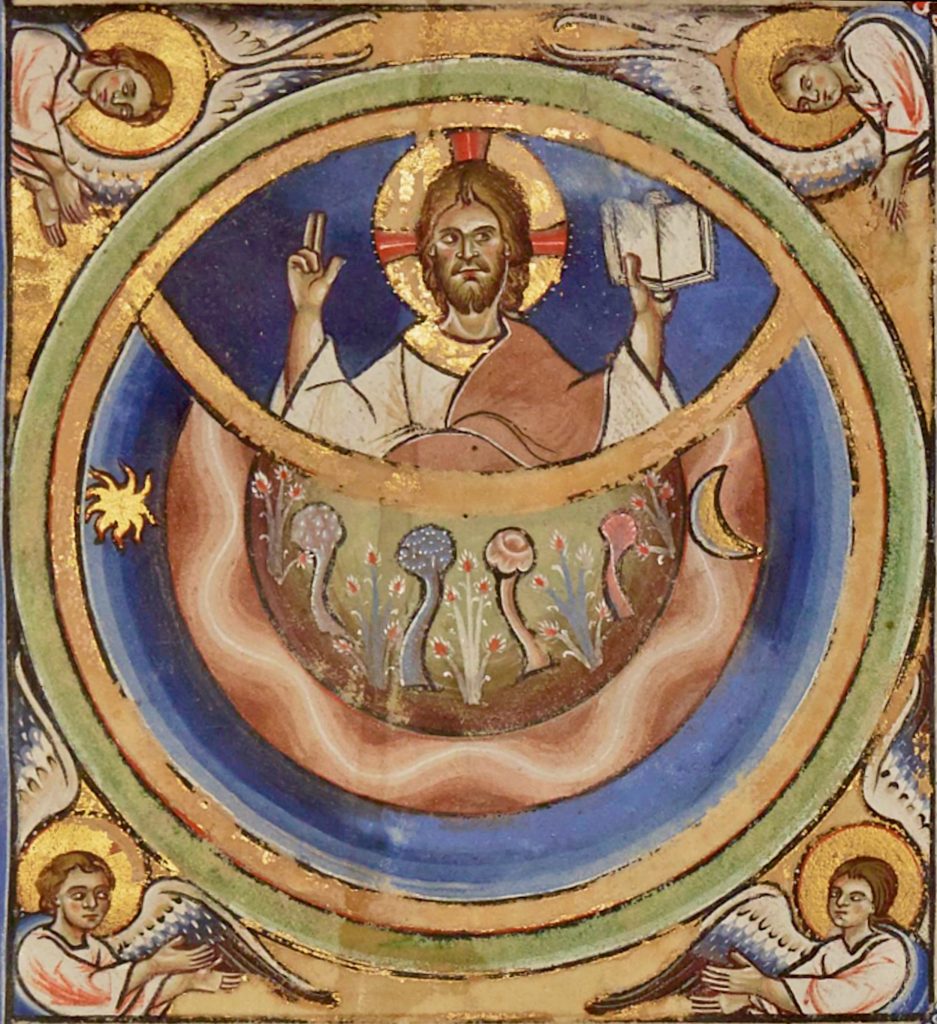
Bibliotheque nationale de France. Public domain image.
The next morning, which was the fifth day, living creatures started to live in the waters, and birds started to live in the skies. Elohim created every kind of animal that lives in the water, and every kind of winged creature that flies in the sky. Elohim told them that they could have babies on their own. Elohim told the sea creatures to fill up the waters, and the birds to settle down on earth. It took one day to create all these creatures, but no one knows how long that fifth day lasted. For all we know, the fifth day and night lasted so long we would call it a million years.
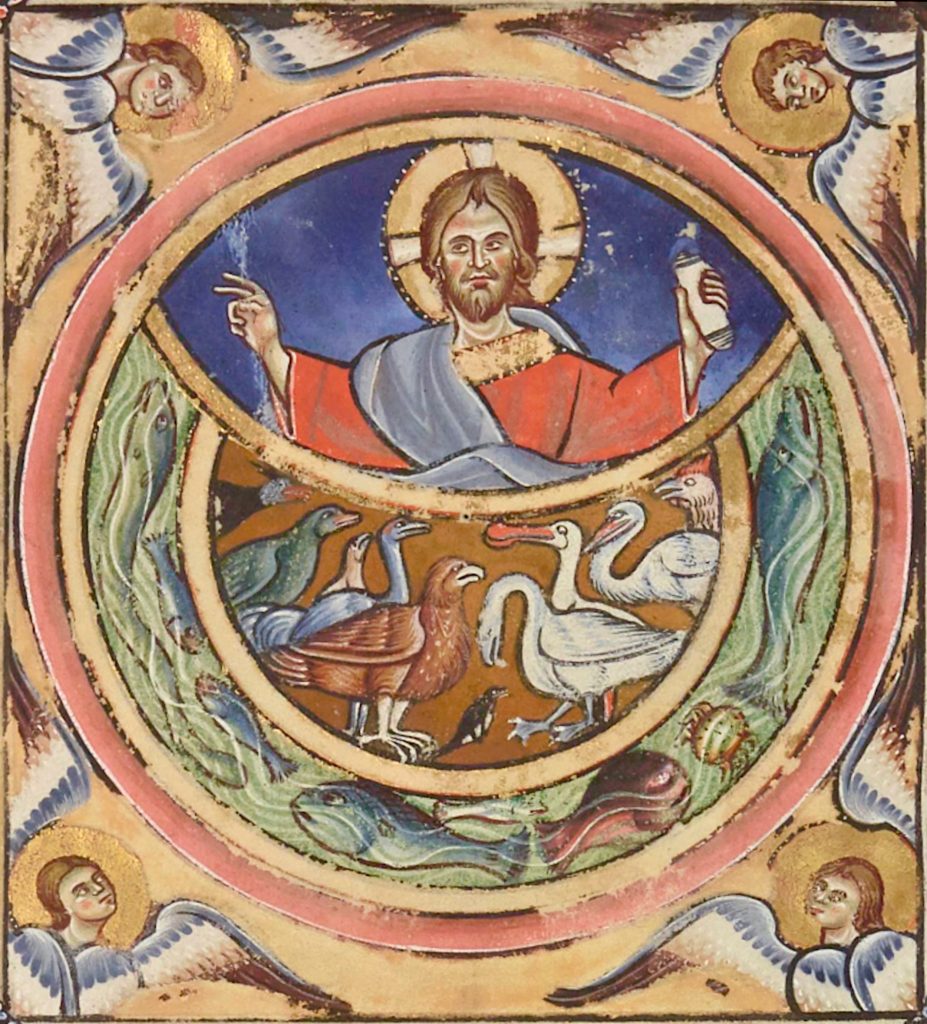
Bibliotheque nationale de France. Public domain image.
On the sixth day, Elohim decided that the land needed more creatures, so Elohim told the earth to bring forth animals. Elohim made all kinds of animals, from mosquitoes to tigers. Elohim liked all the animals.
Elohim made human beings, too. We human beings say that Elohim made us look just like Elohim, that women and men were created to be the exact image of Elohim. Just like the animals, Elohim told the human beings that they could have babies on their own. And Elohim said to the first human beings, “Because I made you in my image, you are responsible for all the creatures in the sea, and all the creatures who live on land. Rule over them wisely.”
After that, Elohim told all the animals, and the human beings, that they could eat the plants that had come forth from the earth. “Everything that has the breath of life,” said Elohim, “shall eat plants for food.” That was the end of the sixth day. It must have been a very long day, but once again no one knows just how long that day lasted.

Bibliotheque nationale de France. Public domain image.
At last, Elohim felt that everything was finished. Now there was light and darkness; and the dome of the sky; and the oceans and earth with green plants; and sun and moon and stars; and creatures of the water and of the air; and creatures who lived on dry land including human beings.
But not quite everything was finished. On the seventh day, Elohim made a different kind of day. Elohim blessed this seventh day and rested, and Elohim admired light and dark and day and night, the sky and the water, the plants growing on dry land, the sun and the moon and the stars, all the creatures in the water and all the birds in the air, the animals and the human beings. Some people say that Elohim liked everything that existed, but felt there needed to be a reason for everything to exist, and that was why Elohim made the seventh day.
Source: The King James and New Revised Standard Versions of the Bible, altered, Genesis 2.4-3.24.
Session 4: The First Seven Days
Materials
If you choose to do the comic book activity, print out the comic book template below.
I/ Opening
Take attendance.
Light chalice with these words and the associated hand motions: “We light this chalice to celebrate Unitarian Universalism: the church of the open mind, the helping hands, and the loving heart.”
Check-in: Go around circle. Each child and adult says his or her name, and then may say one good thing and one bad thing that has happened in the past week (anyone may pass).
Review last week: If you took photos of last week’s skit, show them to the children, and have them help you post them on the class bulletin board (remember to leave lots of room on the class bulletin board for pictures from future classes).
II/ Read the story
Read “The First Seven Days of Time.”
III/ Act out the Story
By now, the children should be fairly adept at acting out the story. But this story doesn’t have as clearly defined characters, and it may prove to be more challenging. Acting out this story is less like a skit, and more like interpreting the story through movement.
Ask: “What happened first in the story? Then what happened? then what happened?” — and so on, until (with your help and prompting as needed) the children have remembered what happened in the story.
Determine where the stage area will be. Children who are not actors may sit facing the stage area.
The lead teacher reads the story, prompting actors as needed to act out their parts. The lead teacher may wish to simplify the story on the fly, to make it easier to act out.
IV/ Conversation about the story
Sit back down in a group.
Ask some general questions: “Have you heard this story before? What was the best part of the story? Who was your favorite character? Who was your least favorite character?” — or questions you come up with on your own.
There are some resemblances between this creation story and last week’s creation story. You might want to see if the children notice these similarities. If you wish, review last week’s story by asking if any of the children remember how Obatala created the world; how is that similar to the way Elohim created the earth in this story, and how is it different?
You can continue the conversation in any way you wish.
V/ Optional sequential art activity
This story lends itself well to illustration in sequential form. Below are two possibilities.
1. Group illustration of the story
Have each child illustrate one of the seven days. If you have more than seven children, the later days can be broken up. E.g., if you have ten children: day three can be broken up into creating dry land, and plants; day five can be broken up into creating creatures of the air, and creatures of the water; day six can be broken up into creating humans, and all other animals.
For those drawing days one, two, and four, it might be helpful to refer to the drawing of the ancient Hebrew conception of the universe.
As the illustrations are completed, you can post them on the class bulletin board, in the order the scenes would come in the story.
2. Comic book version of the story
If you don’t want to do a group project, or if you don’t have a class bulletin board, you can have the children draw sequential art in the form of comic book pages of the story. The illustrations don’t have to be complicated — stick figures work perfectly well (see my sample comic book page below). Besides, simple drawings work best when you have limited time.
To save even more time, here’s a printable comic book page template:
Some children may feel they don’t know how to make a comic book page of the first seven days. If you wish, you can show them my sample comic book page below.

VI/ Building community through play
If you don’t want to do the art activity, you can set aside more time for play.
Game ideas to build community through play: “Duck, Duck, Goose” (yes, this age group finds this game amusing) or other games.
VII/ Closing circle
Before leaving, have the children sit or stand in a circle.
When the children are in a circle, ask them what they did today, and prompt them with questions and answers. If any parents have come to pick up their children, invite them to join the circle (so they can know what it is their children learned about this week).
After you’ve reviewed what the children learned for a couple of minutes, say together some closing words, either the ones below or something you choose. Tell the children how you enjoyed seeing them (if that’s true), and that you look forward to seeing them again next week.
Go out into the world in peace,
Be of good courage,
Hold fast to what is good,
Return to no one evil for evil.
Strengthen the fainthearted
Help the suffering;
Be patient with all,
Love all living beings.
